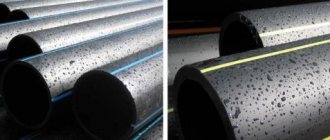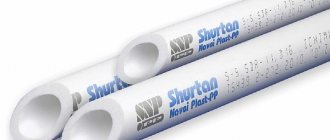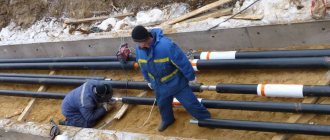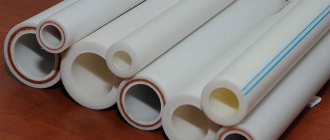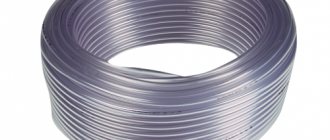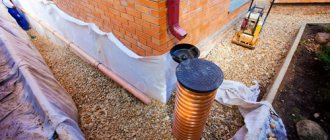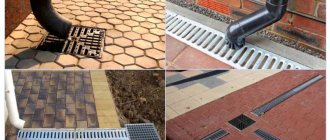Residents of multi-storey buildings most often do not pay attention to where the water goes after a rainstorm or during the melting of snow. But the problem of storm water drainage must be fully resolved by the owners of private houses.
We welcome our regular reader and offer him an article about what pipes are used for storm drainage.
We want to live in a clean, well-kept house, without puddles and puddles on the paths, streaks on the walls, stagnant liquid in the garden, on the surface of the beds and flower beds after a rainstorm. All these problems are solved by a drainage system consisting of surface water intakes and a pipeline system for discharging wastewater into the municipal sewer.
Storm drainage system
Storm drainage or rainwater drainage is a sewerage system designed to organize the rapid removal of precipitation or melt water. In cities and large comfortable settlements, there are collectors, which are connected to local systems for draining atmospheric water from various objects - residential buildings, workshops, warehouses, farms, public buildings, streets and sidewalks, private houses.
Storm drainage can be of the following types:
- Open - storm water is drained using special trays or gutters, open ditches, canals, irrigation ditches.
- Closed, or deep - wastewater, after being collected in trays, enters wells and, using a system of underground pipelines, is discharged into natural reservoirs (rarely to treatment plants).
- Mixed - part of the system consists of closed pipelines, part consists of open trays and channels.
Local systems are divided into point and linear.
It should be borne in mind that the installation of surface storm drainage in no case replaces the installation of wall drainage around the foundation of buildings. Such drainage is installed below the freezing level to protect buildings from groundwater.
Open and deep storm drain
An open storm drainage system consists of drainage ditches and channels, storm drains from trays with gratings, storm water inlets for vertical drainage of drainage systems on buildings, wells for collecting fallen water and transferring it to a transportation system (open or closed). The open system simultaneously serves to collect and transport water.
Canals (aryks) are generally about fields or (sometimes) they are an open collector that transports runoff to natural receivers (rivers, lakes, ponds, rates, streams, ravines). Drainage ditches are used to drain fairly large swampy areas - they take up quite a lot of space and are usually not used in small urban areas. In household plots and in the city sewerage system, trays and point storm water inlets are used; storm water inlets are also used to receive water from the drainage system of buildings.
A deep storm drain is a system of pipelines and collectors that transports rain and melt water collected from the surface into a municipal sewer and further into natural (in rare cases artificial) water intakes. Storm drainage transport pipeline systems are sometimes confused with deep drainage that protects buildings and drains wetlands. These two systems have very different designs and purposes. Deep drainage cannot quickly collect and drain fallen water - this requires surface storm water inlets.
Point and line
Linear sewerage is a system of storm drains covered with gratings, or a system of pipes, or a system of ditches and channels.
Point sewerage - storm water inlets that collect liquid from the drainage system, or from individual places on the sidewalk, road, walkway, lawn or flower garden. Stormwater inlets are covered with a grate on top and equipped with a trash can to retain leaves and large debris; sometimes the design has a sand trap. The drainage from the storm inlet is discharged either through a pipe or through a tray with a grate.
Internal and external piping
The part of the drainage route going from household appliances to the common risers and outlet is called intra-house or internal. Usually it is not subject to external mechanical loads, but it can be pressure (reset is carried out due to additional pumping).
Such bends and their joints must maintain the design pressure, be lightweight, and also convenient to replace nodes and supplement the network with new bends in the event of reconstruction. The internal system must also withstand temporary high (up to 100 C) and current (50–70 C) temperatures of domestic wastewater, as well as the high content of aggressive substances (acids, alkalis) in them in an undiluted state.
The common house drain goes outside - where the sewage system, going underground, usually needs thermal insulation. In harsh climatic conditions and with small diameters, additional insulation measures are used in the underground part of the system (up to the laying of a heating electric cable).
Nevertheless, the external sewage system must withstand even the freezing of its contents. It is also larger in diameter, flexible and strong enough to withstand lateral, static and dynamic loads from above. External systems are usually self-flowing - that is, the flow is carried out only due to the difference in levels.
The diameters of the sewer pipes connected to household appliances are standard (the largest is to the toilet, due to the need to quickly discharge a large volume of water). In an apartment building, the risers are designed with the necessary reserves.
Important: the diameter of the sewer pipe is calculated as the sum of the loads on all household appliances in the house + the possible connection of outlets to drain the area.
Advantages of using stormwater pipes
Pipes are not very suitable for collecting water from the surface - trays and storm inlets are used for this. But for transporting pipes it is more convenient than surface systems. Their advantages:
- The main advantage is the ability to lay at some depth in any convenient place - across and along roads, sidewalks, lawns, green spaces. Laying open trays is not always convenient; trays and gutters are not allowed to flow through large quantities of water. But pipes come in very large diameters. Laying ditches and open channels in the city takes up a lot of space and is unsafe - a person can fall into them. There are cities in Russia with very heavy rainfall and canal systems - and there are regular news reports of canal-related injuries and accidents. When constructing open ditches on a private property, the danger to household members only increases.
- Laying pipelines is much cheaper than installing concrete channels and ditches. This applies to draining large quantities of water, laying large diameter pipes and laying channels or ditches. But if you have a choice on your site - lay gutters with gratings or bury a pipe with a diameter of 100 mm to a depth of 1 m, then it is easier, of course, to lay a tray with gratings. In addition, the surface system is easier to clean.
- Joining pipes is not particularly difficult - all kinds of couplings, tees, turns and other components are available for almost any pipe.
Corrugated pipelines
When designing a storm sewer, what pipes to assemble it from is the main question. The main problem is the large number of compounds, each of which becomes a risk factor. Straight pipes require appropriately shaped trenches. If you need to go around any objects, you have to use fittings of the desired shape. All these difficulties can be eliminated by using corrugated pipes.
They are long and can bend in any direction, so they do not require fittings. The only exceptions are areas of junction and branching. Corrugated pipelines are available in standard sizes. The greatest demand is 110 mm (for the internal part) or 200 mm (for the external parts of the system). The only drawback of these channels can be considered the presence of multiple irregularities on the inner walls. To eliminate the risk of blockages, you should use effective sand trap filters, which must be cleaned periodically.
What happens if you choose wrong?
The wrong choice of pipes for the storm and melt water drainage system is fraught with the following troubles:
- During heavy rainfall, wastewater will not have time to flow into the sewerage system and will accumulate on sidewalks, paths, green areas, roads, playgrounds, etc. Water will interfere with pedestrians and vehicles, and electric vehicles will have to be stopped altogether (due to safety requirements).
- Runoff can wash away lawns, flower beds, and vegetable gardens; in areas with a large slope it can seriously damage the top fertile layer and cause soil erosion.
- But the most unpleasant thing is if water from the roofs of buildings accumulates in the storm water inlet area and seeps into the soil near the foundation. This can cause the foundation and walls to become soaked, water seeping into the basement, and mold and mildew to develop.
We select a pipeline for a private house and country house
Procedure:
- Count all connected equipment and sort by load on the network (toilets and bidets discharge large amounts of weight at a time). Using the table above, select what diameter you need to connect to them.
- Calculate the loads on the risers and the overall output. For a private house - the diameter of the external drain (domestic sewer + rainwater).
- Separately, equipment that discharges water close to boiling is highlighted. Based on this, specify the material that is most suitable in this case.
- The resulting system (bends, riser, fan, external outlet) will most likely be combined in materials (PVC + metal). Some types of systems, which are expensive to install (concrete), pay off over a long service life.
- Having marked the approximate laying diagram, keep in mind that turns are cut at 45 degrees and blockages usually occur in these areas and on the branches of the system. If there are no connected devices nearby, it makes sense to install inspection holes.
Remember that the calculation is carried out with a reserve (in apartment buildings, common building risers already take into account possible loads, but may not hold pressure).
Types of pipes
A wide variety of pipe types are used to drain stormwater. In recent decades, modern and very diverse plastic ones have been added to the traditional cast iron, steel and concrete ones.
Asbestos-cement
Asbestos-cement pipes for stormwater drainage have been used for a very long time. They do not rust, are relatively durable, quite durable, and chemically inert. But recently, due to their shortcomings, they have lost their former popularity. Disadvantages: weight, fragility, cost, lack of ready-made fittings, difficulty of installation. Service life is 30 years, which by today's standards is not very long.
Metal
That is, steel pipes. Durable, reliably connected by welding. Galvanized ones will last 40 years, but the joints rust, just like regular “black” pipes. “Black” pipes, that is, without coating, will last about 25 years. They are heavy, difficult to install and transport. They become overgrown with magnesium and calcium salts and rust.
Cast iron
Bell-shaped products are quite easily assembled into a pipeline. Very heavy, durable, reliable, can last for 50 years. They become overgrown with salts and rust, but more slowly than steel ones.
Plastic
For underground pipelines, polyvinyl chloride and low-density polyethylene are practically used. Products made from high-density polyethylene are more expensive and are not available in large diameters and are not rigid enough for installation in the ground. Polypropylene is too fragile and costs more. These materials are used only for water supply and indoor heating.
Plastic pipes are characterized by very smooth walls - salts do not settle on them; they do not rust, are chemically inert, and resistant to biological contamination. Smooth walls provide greater speed and volume of discharged wastewater, and the ability to lay the pipeline with a slight slope.
The plastic has sufficient strength and some ductility, it is not fragile. The plastic is mounted using special couplings; traditional socket sewer elements can be used. The price of plastic is low. In earthquake-prone areas, with the risk of landslides and ground movements, the strength of plastic pipelines may be insufficient.
Metal-plastic
The maximum outer diameter of metal-plastic products is 48 mm (inner diameter is 40 mm). The main feature of metal-plastic - the ability to reduce the thermal expansion of the pipe - remains unclaimed when underground installation at a stable cool temperature. Showers are never hot. Therefore, metal-plastic is not used for underground pipelines.
Fiberglass
Fiberglass is a composite consisting of polyester or epoxy resins and glass, basalt or carbon fibers. Lightweight, durable, chemically inert material, not subject to corrosion. Strength comparable to steel. These features make it one of the most promising materials for stormwater drainage. Disadvantage: relatively high price. Installation: traditional assembly of socket elements, like cast iron; assembly of products with flanges; coupling connection; yoke connection (using special fittings and bolts).
PVC
Very durable, lightweight, reliable and inexpensive pipes. Installation is a little difficult - special couplings and glue are required.
Corrugated
The most promising and durable type of plastic pipes. There are single-layer and double-layer, there are many types of fittings. In a two-layer corrugation, the outer wall has bends along its length, the inner wall is smooth. They have all the advantages of single-layer plastic pipes, but are much stronger. The price is slightly higher than single-layer ones, but it more than pays for itself in strength and durability. Double-layer corrugation can last more than 50 years.
Others
Previously, ceramic pipes of large diameters were used - very durable, but heavy, fragile and difficult to install (besides, there are practically no fittings for them). Very heavy reinforced concrete (usually called concrete) pipes of large diameters were also used. Now these species are gradually becoming a thing of the past. Although for very large collectors and where greater strength is required from the pipes, reinforced concrete is still used.
Technical requirements
There are a number of requirements for external storm sewer pipes, namely:
- Strength - they must withstand soil pressure well;
- Heat resistance;
- Resistance to low temperatures for a long time;
- Resistant to moisture and a number of chemicals. Since the system is buried in the ground, it may be adversely affected by the active soil environment and wastewater;
- Smoothness of the internal walls to avoid the formation of accumulations and congestion;
- Considerable length. The fewer connections required, the more reliable the entire system will be.
Which one is better and why?
The best pipe is a two-layer corrugated or fiberglass pipe. Durable (corrugation is also plastic). If you have an earthquake-prone area or there is a danger of landslides, you will have to lay a steel, cast iron, or fiberglass pipeline. But if you need to lay a pipeline to the collector at a depth of less than 2 meters and there are no particular difficulties in geology and load on the soil surface, then it is better to choose inexpensive HDPE or PVC pipes and not bother. They will last for 50 years. And maybe more.
Calculation of pipeline diameter
To calculate the diameter, you first need to calculate the amount of liquid drained using the formula:
Q=q20*F*φ, where
Q is the amount of water that the sewer system should remove when it rains;
q20 – intensity of precipitation for 20 minutes. This information is available from your local surveyor's office;
F – area of the plot or house. The area of the house is equal to the area of the horizontal projection of the house (taking into account the roof overhang). There is no need to calculate the area of the roof slopes;
φ – correction factor depending on the type of surface of the protected area. It depends inversely on the ability of the surface to absorb water. For asphalt – 0.95; for concrete – 0.85, for roofing – 1.0; for crushed stone – 0.4; for soil - 0.75, sand or gravel - 0.4.
The diameter is determined according to the Lukin tables. Knowing the water flow rate in l/s, you can determine the required pipe diameter. The ratio h/D (the height of the pipe filled with liquid to the internal diameter of the pipe) should be taken equal to 1. Tables and counters based on them are easily available on the Internet.
Approximate price (table)
In a standard urban area, pipes with an outer diameter of 110-160 mm are most often used. Prices for products of these diameters are shown in the table.
| Material | Diameter, mm, wall thickness, mm | Price 1 m |
| Steel | 108×4 | 550 |
| Steel | 159×4 | 810 |
| HDPE | 110×10 | 160 |
| HDPE | 160×14,6 | 330 |
| PVC | 110/4 | 190 |
| PVC | 160\4 | 320 |
| Double-layer corrugation | 110 | 130 |
| Double-layer corrugation | 160 | 200 |
Fiberglass pipes are produced with a diameter of 300 mm or more - they are not suitable for a private home.
Technical characteristics of pipes for rainwater drainage
Pipes that will be used to equip the stormwater system must comply with their operating conditions:
- strength - consumables must withstand various mechanical impacts, including compression, bending and shock;
- tolerance to ultraviolet rays - pipes installed on the surface of the site must withstand exposure to sunlight;
- resistance to aggressive reagents - sediments with various impurities will flow through the system;
- resistance to temperature changes - the consumable will remain in the same position all year round. Therefore, it is recommended to give preference to pipes that are resistant to winter and summer temperatures.
What to consider when installing pipes
The main condition is that under the pipe you need to make a cushion of 15 cm of fine crushed stone and 15-20 cm of sand, fill it with sand, pour a 15-20 cm layer of sand on top. Filling it with sand will protect the pipe during small subsidence of the soil and during heaving due to freezing.
There must be a slope of at least 2 mm (not 1-2%!) per linear meter and there must be no areas with a negative slope (with pipe deflection).
You should not make a storm drain with a diameter smaller than 100 mm - you will have to clean it more often.
Under roads and vehicle areas, the plastic pipeline must be installed in a sheath made of steel pipe.
The pipes will have to be cleaned. Therefore, the pipeline must have wells. Cumulative or for cleaning - any. The distance between wells should not exceed 50 m, and there should not be more than one turn of the pipeline between them (in this case, wells will have to be installed more often).
Installation nuances
The laying of storm sewer pipes is necessarily preceded by a preparatory stage, which includes drawing up an accurate diagram that takes into account the features of the landscape.
Note! It is more correct to lay a closed storm drain below the freezing point of the soil. If this is fraught with great difficulties, it is worthwhile to provide additional thermal and waterproofing of the pipeline.
The pipes are laid on a gravel or sand base. If the pipeline is deeply buried, to reduce the pressure on the pipeline, it is backfilled in two stages: a second layer is poured on top of the carefully compacted low lower layer. To make it possible to carry out cleaning or repair activities, it is worth considering the insertion of special inspection elements. It is more correct to install these elements near the turns of the main route - in places where blockages are most likely to form. Also, depending on the steepness of the turn and the selected pipe material, it may be necessary to install special fittings.
To ensure free flow of water and the possibility of self-cleaning, storm drains are laid with a slight slope. As a rule, a slope of 2-3 cm is sufficient for the normal functioning of the system.
Inside the house
First of all, begin the installation of internal sewerage. To do this, you need to decide where all the plumbing units will be located: toilets, sinks, bathtubs, dishwasher. Installation of water supply from PVC pipes is carried out from the drainage sources to the central riser.
Before starting work, draw an approximate diagram that will allow you to calculate the number of pipes and connecting elements. Buy PVC material with a small supply.
Sewerage in a private house is installed in two ways: hidden and open. In the first case, the pipes go inside the walls. This is convenient if the house does not have interior decoration. Otherwise, you will have to knock out special tunnels - grooves. An open water supply is installed outside. It will have to be hidden with special boxes. Otherwise, the walls will not look aesthetically pleasing.
Some nuances that are important when installing a sewer system:
1. A PVC pipe with a diameter of 110 mm is used for the riser. This size is relevant in a private house that has two floors;
2. In small housing, it is better to install not two risers, but one central one. And the drains from all nodes are reduced to it. The riser should also have hatches for cleaning the pipe. This will allow you to quickly deal with sewer blockages;
3. A PVC pipe of 100 mm or more must be installed from the toilet;
Modern toilets, which are equipped with economical flushes, as well as branded hanging systems, can be mounted on a 90 mm polyvinyl chloride pipe. This value is the European standard for this type of plumbing. Therefore, when purchasing a high-quality European product, you can install a smaller outlet pipe diameter (90 mm).
4. The diameter of pipes for washing machines and dishwashers does not exceed 30 mm. To the bath, sink and shower - about 30-50 mm;
5. General wiring around the house is made of polyvinyl chloride pipes 40-50 mm;
6. Installation of non-pressure water supply is carried out on a slope. Diameters from 50 to 80 cm are laid with a slope of 2 cm per meter of pipe. Diameter 80-110 requires a slope of 3 cm per meter of pipe.
Definition and regulatory framework
Storm drainage, also known as rain drainage, also known as storm sewer, is a multicomponent engineering system designed to collect and drain precipitation and melt water. But if in most cases it is aimed specifically at getting rid of excess moisture, then in some situations it can also be used to obtain the missing one. When there are problems with water supply in the area, rainwater will be an excellent help. How much can actually be collected from a roof, depending on the area and level of precipitation, can be calculated exactly if desired, but there is also the result of “full-scale tests”.
GerasimForumHouse Member
My statistical patch: a roof of 100 m², a drain in four corners, one corner led into a four-cube font. A full font (from 25 m² of roof) is filled in a month. Not Moscow, but the north of the Moscow region.
And even if this water is technical and “along the way” it will pick up dust and debris, it is quite possible to use it for irrigation and other needs that do not require crystal transparency.
In a more familiar functionality, the storm drainage system of a house, together with the blind area, protects the foundation of the house and other buildings and prevents the formation of stagnant puddles. This is on sandy soils with a low groundwater level and a couple of hours after the rain there is nothing left anywhere. And on clay, and even with high water flow and in the summer, or even in the off-season, without the construction of a storm sewer there will be not a yard, but a swamp.
Although almost all existing standards are advisory in nature in relation to private sector objects, this is not a reason not to use them. Why reinvent another kind of wheel when everything has already been thought out and calculated, all that remains is to apply it. When calculating storm drainage for your country house, you need to focus on the current SP 32.13330.2018 Sewerage. External networks and structures. SNiP 2.04.03-85. At the moment, this is the latest updated edition, developed in another century and another state of rules. It applies to both those under construction and those already in operation and those being reconstructed.
Operation and Maintenance
In order for the storm sewer system to function properly for decades, maintaining its throughput, after construction it is necessary to follow the operating rules and periodically carry out maintenance.
- Stormwater inlets, gutters and other external elements of the storm drainage system of the house must be covered with grates to prevent the entry of large debris.
- After spring floods and downpours, receivers and rotary wells are inspected and cleaned if necessary.
- Every two years, all elements of the system are thoroughly cleaned of debris and sediment, including flushing with a hose.
- Every ten to fifteen years, unless the need arises earlier, major maintenance is performed, flushing the system of sediments and deposits with water under pressure in both directions. Hard blockages are removed using a mechanical method, if the hydrodynamic method does not produce results.
Timely maintenance of individual parts and periodic maintenance of the entire system is the key to trouble-free operation, and if repairs are required, then without the need for dismantling.


